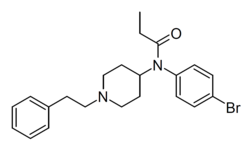Chemistry:4-Bromofentanyl
 | |
| Legal status | |
|---|---|
| Legal status |
|
| Identifiers | |
| |
| CAS Number | |
| PubChem CID | |
| ChemSpider | |
| UNII | |
| Chemical and physical data | |
| Formula | C22H27BrN2O |
| Molar mass | 415.375 g·mol−1 |
| 3D model (JSmol) | |
| |
| |
4-Bromofentanyl (para-bromofentanyl) is an opioid analgesic drug that is an analog of fentanyl and has been sold as a designer drug,[1] first identified in Pennsylvania in the US in March 2020.[2]
Effects
The effects of fentanyl analogs are similar to those of fentanyl itself, which include potent sedation and analgesia, along with side effects such as itching, nausea and potentially serious respiratory depression, which can be life-threatening. Fentanyl analogs have killed thousands of people throughout the world since the most recent resurgence in use began in Estonia in the early 2000s, and novel derivatives continue to appear.[3] A new wave of fentanyl analogues and associated deaths began in around 2014 in the US, and have continued to grow in prevalence; especially since 2016 these drugs have been responsible for hundreds of overdose deaths every week.[4]
Legal status
4-Bromofentanyl is a Schedule I controlled drug in the United States under the fentanyl analogue provisions introduced in 2018, despite not being specifically listed in its own right.[5]
See also
- 4-Chloroisobutyrylfentanyl
- 4-Fluorofentanyl
- List of fentanyl analogues
References
- ↑ "Spectral trends in GC-EI-MS data obtained from the SWGDRUG mass spectral library and literature: A resource for the identification of unknown compounds". Forensic Chemistry (Amsterdam, Netherlands) 31. December 2020. doi:10.1016/j.forc.2022.100459. PMID 36578315.
- ↑ "Bromofentanyl Analytical Report". Novel Psychoactive Substances (NPS) Discovery. Willow Grove, PA: The Center for Forensic Science Research & Education (CFSRE). 17 December 2020. https://www.cfsre.org/images/monographs/Bromofentanyl_121720_CFSRE_Toxicology_Report.pdf.
- ↑ "Fentanyls: Are we missing the signs? Highly potent and on the rise in Europe". The International Journal on Drug Policy 26 (7): 626–631. July 2015. doi:10.1016/j.drugpo.2015.04.003. PMID 25976511.
- ↑ "Fentanyl, fentanyl analogs and novel synthetic opioids: A comprehensive review". Neuropharmacology 134 (Pt A): 121–132. May 2018. doi:10.1016/j.neuropharm.2017.10.016. PMID 29042317. https://escholarship.org/uc/item/8xh0s7nf.
- ↑ "Fentanyl-related substance scheduling as an effective drug control strategy". Journal of Forensic Sciences 66 (4): 1186–1200. July 2021. doi:10.1111/1556-4029.14712. PMID 33951192.
 |

